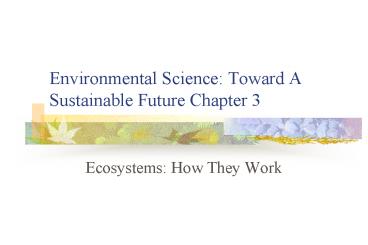Environmental Science: Toward A Sustainable Future Chapter 3 - PowerPoint PPT Presentation
1 / 33
Title:
Environmental Science: Toward A Sustainable Future Chapter 3
Description:
Destruction of tropical rain forests. Nutrient overcharge into aquatic ecosystems. ... Gas, climate and water regulation. Water supply. Erosion control. Soil ... – PowerPoint PPT presentation
Number of Views:216
Avg rating:3.0/5.0
Title: Environmental Science: Toward A Sustainable Future Chapter 3
1
Environmental Science Toward A Sustainable
Future Chapter 3
- Ecosystems How They Work
2
This Lesson Is About How Ecosystems Function
Transfer Energy and Nutrients
- Capture of sun energy transfer through different
trophic levels. - Capture of essential elements of life and
transfer through different trophic levels. - Nutrient cycles.
- Human impacts on ecosystem function.
3
Ecological Principles DICE
Diversity Interrelationships Cycles Energy
4
Elements of Life
92 naturally occurring elements Elements Found
in Living Organisms N CHOPS (macronutrients) C
HOPKINS Ca Fe Mg B Mn Cu Cl Mo Zn
5
Atmospheric Gases
78 Nitrogen
21 Oxygen
lt0.04 Carbon Dioxide
6
Elements of Life
Organic carbon based molecules produced by
living organisms Example C6H12O6,
CH4 Inorganic molecules without carbon-carbon
nor carbon-hydrogen bonds Example NaCl, NH4,
H2SO4
7
Matter and Energy
- Matter anything that occupies space and has
mass. - Cannot be created or destroyed.
- Can be changed from one form into another.
- Can be recycled.
- Can be measured where gravity is present.
8
Matter and Energy
- Energy anything that has the ability to move
matter, has no mass and does not occupy space.
Ability to do work! - Cannot be created or destroyed.
- Can be changed from one form to another.
- Cannot be recycled.
- Can be measured.
9
Laws of Thermodynamics
First Law (CHANGE) Energy is neither created
nor destroyed but may be converted from one
form to another. NO FREE LUNCHES! Second Law
(LOSS) In any energy conversion, you will end up
with less usable energy than you started with.
YOU CAN T BREAK EVEN!
10
Laws of Thermodynamics
Second Law Energy is lost in the energy
conversion process, as heat. The energy value of
work performed will always be less than the fuel
it consumes.
11
Entropy
- Systems will go spontaneously in one direction
only which is toward increasing entropy.(disorder)
12
Example of the Laws of Conservation of Matter and
Thermodynamics
13
First Principles of Ecosystem Sustainability
- Ecosystems use sunlight as their source of
energy. - The source of all energy is the sun.
- All elements are recycled
14
Elements of Life
Produces energy in plants Produces glucose
(sugar) oxygen
Photosynthesis 6 CO2 6 H20
C6H12O6 6 O2
Cell Respiration C6H12O6 6 O2
Uses energy in animals
6 CO2 6 H20
15
Photosynthesis
- Natural process
- Converts atmospheric inorganic carbon
- To organic forms of carbon found in living
systems - Happens in plants
- Sunlight is the source of all energy
- For plants
- For other living organisms
16
The First Principle of Ecosystem Sustainability
At Work
17
Match Outcomes (Left) With Process (Right)
- Releases O2
- Stores energy
- Releases CO2
- Uses CO2
- Releases energy
- Produces sugar
- Uses sugar
- Uses O2
- Photosynthesis
- Cell respiration
- Both
- Neither
18
Match Outcomes (Left) With Organisms (Right)
- Releases O2
- Stores energy
- Releases CO2
- Uses CO2
- Releases energy
- Produces sugar
- Uses sugar
- Uses O2
- Plants
- Animals
- Both
- Neither
19
The Second Principle of Ecosystem Sustainability
- Ecosystems dispose of wastes and replenish
nutrients by recycling all elements.
20
The Carbon Cycle
- How and in what form does carbon enter and leave
the cycle? - What are the human impacts on the cycle?
- Fossil fuel burning is an anthropogenic cause of
return of carbon to the atmosphere
21
(No Transcript)
22
The Phosphorus Cycle
- How and in what form(s) does phosphorus enter and
leave the cycle? - How is the role of autotrophs and heterotrophs
different and the same? - What are the human impacts on the cycle?
- Inadvertent fertilization of waterways
- Accumulation of phosphorus rich pollutants in the
atmosphere - Depletion of soil supplies by overharvesting and
erosion
23
(No Transcript)
24
The Nitrogen Cycle
- How and in what form(s) does nitrogen enter and
leave the cycle? - How is the role of autotrophs and heterotrophs
different and the same? - What are the human impacts on the cycle?
- The addition of fertilizer to soil contributes to
the nitrogen cycle - Farmers plant legumes (soybeans) to enrich the
soil with nitrogen. - Nitrogen fixation is the process by which
microbes work with the legume to produce the
nitrogen - Converting the nitrogen gas to a chemical form
the plant can use
25
Nitrogen fixation
26
(No Transcript)
27
The Human System
28
The Human System
29
Violations of the First Principle of Ecosystem
Sustainability
- Excessive use of fossil fuels.
- Feeding largely on the third trophic level.
- Use of coal or nuclear power.
- Use of agricultural land to produce meats.
30
Violations of the Second Principle of Ecosystem
Sustainability
- Lack of recycling.
- Excessive use of fertilizers.
- Destruction of tropical rain forests.
- Nutrient overcharge into aquatic ecosystems.
- Production and use of nonbiodegradable compounds.
31
Ecosystem Services and Functions
Gas, climate and water regulation Water
supply Erosion control Soil formation Pollination
Biological control
32
Ecosystem Services and Functions
Food production Recreation Raw materials Nutrient
cycling Waste treatment
33
Solar Energy
- Drives the following cycles
- Carbon
- Water
- Nitrogen
- Phosophorus

